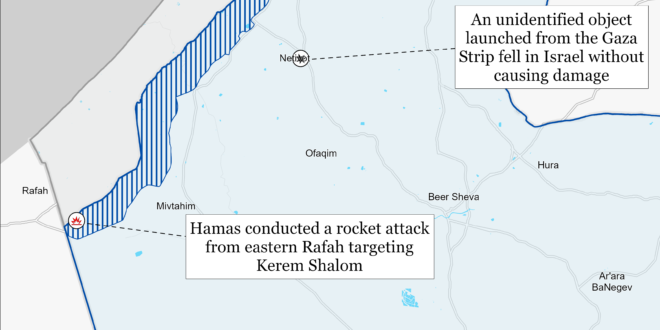Israeli forces are re-clearing parts of the northern Gaza Strip, demonstrating that Hamas remains active beyond just Rafah.[i] The Israel Defense Forces (IDF) launched a clearing operation into Zaytoun neighborhood, southern Gaza City, on May 8, marking the third time that the IDF has conducted a clearing operation there.[ii] The IDF began by conducting airstrikes targeting Palestinian militia observation posts, sniper positions and tunnels.[iii] Three IDF brigades subsequently entered the area.[iv] These brigades have since then engaged Palestinian militias, including Hamas, in Zaytoun as well as in nearby Sabra neighborhood and along the Netzarim corridor.[v] A Palestinian social media account reported that civilians are evacuating areas in and around Zaytoun since the Israeli clearing operation began there.[vi]
This most recent Israeli clearing operation highlights that Hamas remains active and combat effective in the northern Gaza Strip, despite repeated Israeli clearing efforts there. Hamas infiltrated and began reconstituting itself in the northern part of the strip after the IDF withdrew from the area in December 2023.[vii] Hamas has since then conducted dozens of attacks targeting Israeli forces in and around the northern Gaza Strip.[viii] Hamas is almost certainly trying to reconstitute around Khan Younis since the IDF left there in April 2024.
Hamas’ remaining presence throughout the Gaza Strip supports CTP-ISW’s assessment that Hamas expects that it would survive an Israeli clearing operation into Rafah.[ix] Hamas likely calculates that it could rebuild itself in Rafah in the same way that it is currently in the northern Gaza Strip. This confidence has informed Hamas’ decision to maintain its maximalist ceasefire demands since December 2023.
An Israeli Army Radio correspondent noted that the IDF will need to continue to conduct clearing operations around the Gaza Strip until there are serious conversations about a replacement to Hamas as a local governing authority.[x] The absence of a governing authority, including a local security force besides Hamas, will provide Hamas space and time to reassert itself in the strip.
Iran and Zimbabwe have held a flurry of meetings in recent weeks to discuss economic, military, and political cooperation. Zimbabwean Science and Technology Minister Amon Murwira has most recently led a delegation to attend an international technology exhibition in Tehran between May 7-10.[xi] The exhibition is at least ostensibly meant to promote business cooperation between Iranian and foreign companies. The Iranian Defense Industries Training and Research Institute is participating in the exhibition, suggesting that Iran wants to use the event to promote military cooperation as well.[xii] The institute, which operates under the Iranian Defense and Armed Forces Logistics Ministry, is responsible for designing military equipment and systems and working with foreign partners to gain technical knowledge of advanced weapons systems.[xiii] Atomic Energy Organization of Iran Director Mohammad Eslami previously served as the head of this institute.[xiv] Murwira met with the Iranian vice president for science, technology, and the knowledge-based economy on the sidelines of the exhibition on May 8.[xv]
This exhibition follows other recent engagements between Iran and Zimbabwe. Zimbabwean Vice President Constantino Chiwenga met with Iranian President Ebrahim Raisi and Defense Minister Brig. Gen. Mohammad Reza Ashtiani, among other Iranian officials, in Tehran in late April 2024.[xvi] Zimbabwe also participated in the inaugural Iranian Nuclear Science and Technology Conference in Esfahan City between May 6-8.[xvii] [xviii]
Key Takeaways:
- Northern Gaza Strip: Israeli forces are re-clearing parts of the northern Gaza Strip, demonstrating that Hamas remains active beyond just Rafah.
- Iran: Iran and Zimbabwe have held a flurry of meetings in recent weeks to discuss economic, military, and political cooperation.
- Southern Gaza Strip: US President Joe Biden said that the United States will stop supplying Israel with certain weapons if Israel conducts a major military operation into Rafah.
- West Bank: Israeli forces engaged Palestinian fighters in at least one location in the West Bank.
- Southern Lebanon and Golan Heights: Lebanese Hezbollah conducted at least six attacks from southern Lebanon into northern Israel.
- Iraq: The Islamic Resistance in Iraq—a coalition of Iranian-backed Iraqi militias—claimed three attacks targeting Israel.
- Syria: Israel was likely responsible for an airstrike targeting a Harakat Hezbollah al Nujaba site in Sayyida Zeinab, Syria.
- Yemen: Houthi supreme leader Abdul Malik al Houthi said during a speech that the Houthis would escalate attacks against Israel following Israel’s limited operation into Rafah.
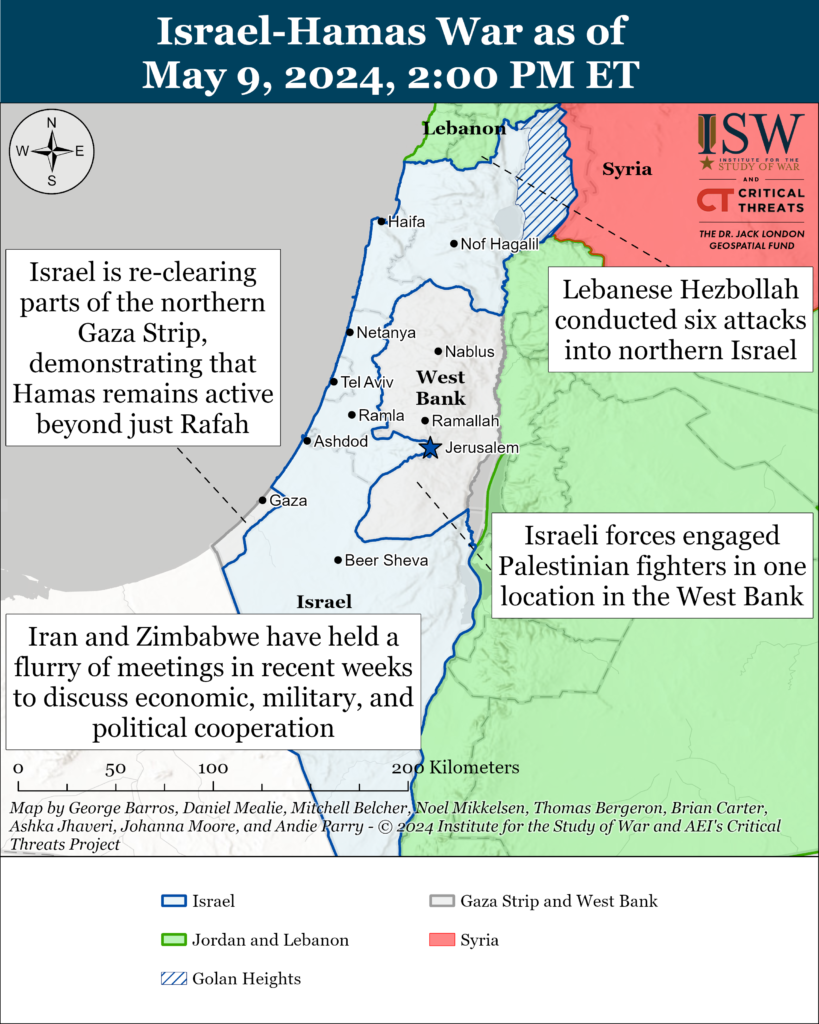
Gaza Strip
Axis of Resistance objectives:
Erode the will of the Israeli political establishment and public to sustain clearing operations in the Gaza Strip
Reestablish Hamas as the governing authority in the Gaza Strip
Israeli forces continued to conduct a limited operation into eastern Rafah on May 9. Israeli forces have destroyed 10 tunnel shafts and killed around 50 Palestinian fighters since entering eastern Rafah, according to Israeli media.[xix] Hamas detonated a tunnel shaft there, moderately injuring three Israeli soldiers.[xx] Palestinian militias also fired small arms and conducted indirect fire attacks targeting Israeli forces entering eastern Rafah.[xxi] Commercially available satellite imagery from May 8 shows flattened terrain south of al Bayuk, indicating that Israeli armor and/or other heavy vehicles entered the area. A Palestinian journalist citing local reports said that the IDF sent bulldozers into eastern Rafah.[xxii] Israeli forces continue to control the now-closed Rafah crossing between Egypt and the Gaza Strip.[xxiii] The IDF estimates that around 150,000 Palestinians have evacuated eastern Rafah since the Israeli evacuation orders were issued.[xxiv] A Palestinian journalist reported on May 9 that residents and displaced people civilians are moving toward Deir al Balah.[xxv]
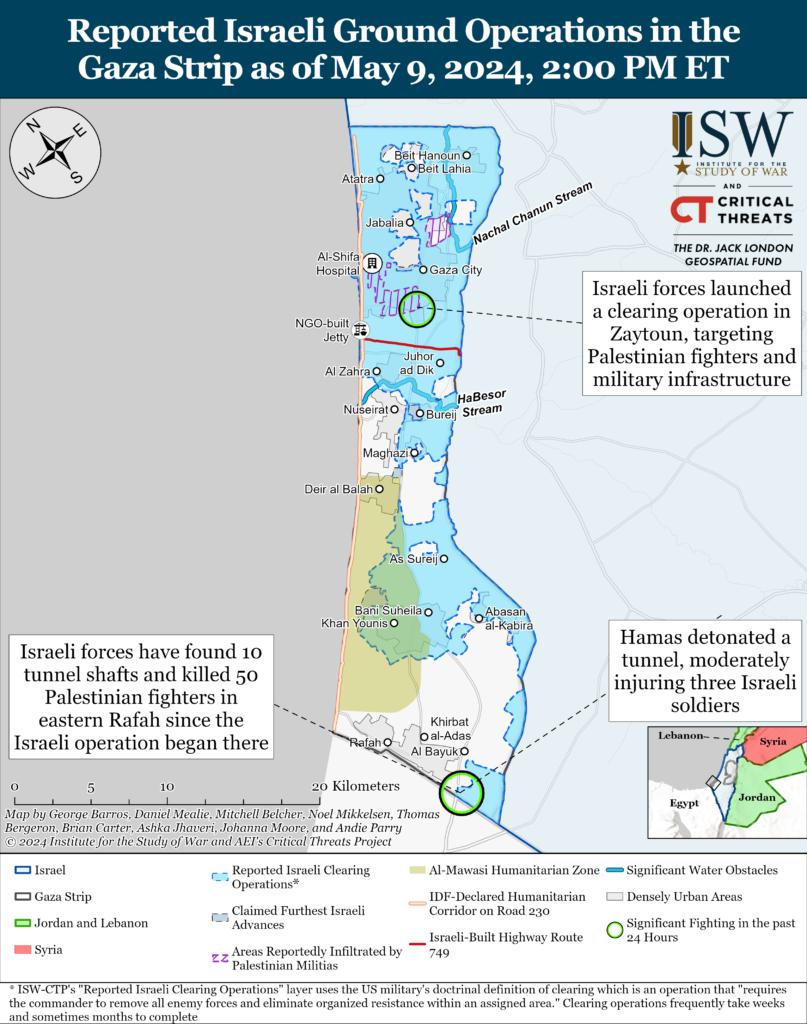
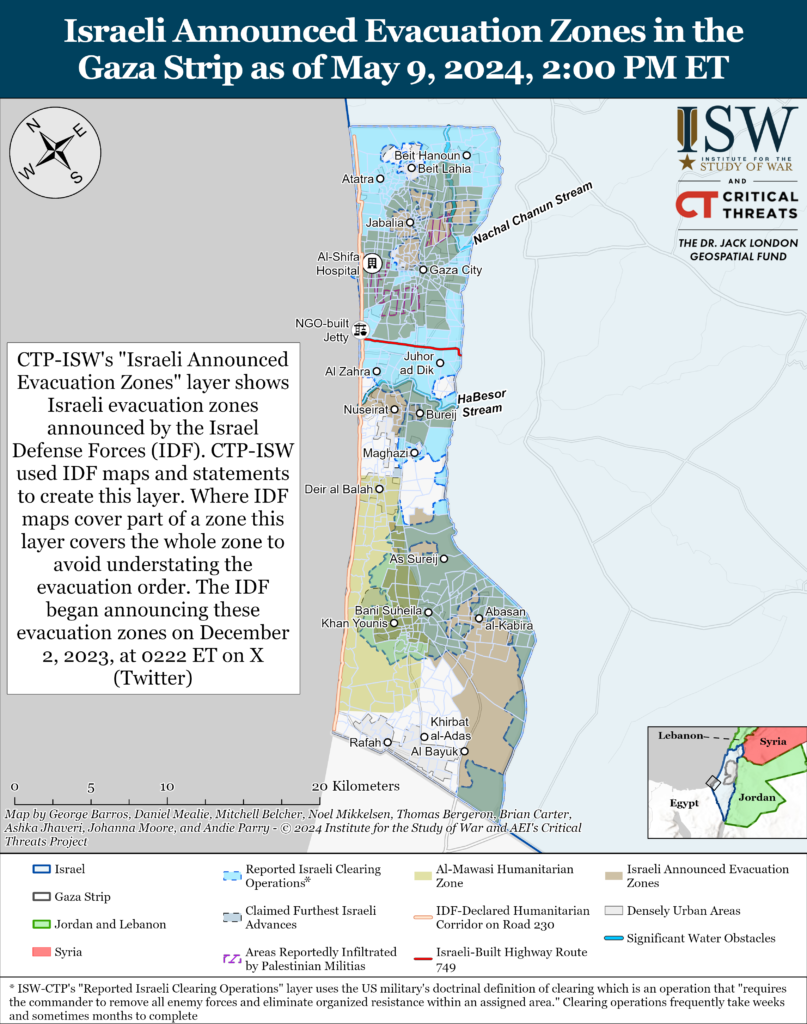
US President Joe Biden said that the United States will stop supplying Israel with certain weapons if Israel conducts a major military operation into Rafah.[xxvi] He said that, should Israel advance military operations into populated areas, the United States would not supply artillery shells, bombs for fighter jets, and other unspecified offensive weapons during a televised interview with CNN published on May 8.[xxvii] Biden acknowledged that Israel using US-made bombs in populated areas has killed Gazan civilians. Biden added that the limited Israeli operation to control the Rafah crossing did not cross a ”red line” that would shift US policy. He also clarified that the United States would continue helping Israel to defend against attacks from foreign actors. The interview with Biden came after the United States confirmed on May 8 that it paused a shipment of weapons to Israel due to US concerns over Israeli operations in Rafah.[xxviii]
The Israeli war cabinet is set to meet to discuss Biden’s comments, according to an unnamed Israeli official.[xxix] An IDF spokesperson said after Biden’s interview that Israel has the weapons needed for operations in Rafah.[xxx]
Four unspecified US officials told NBC that Israel has refused to agree to a ceasefire deal with Hamas unless the IDF can proceed with a military operation into Rafah.[xxxi] The officials said that the Netanyahu government wants to conduct military operations into Rafah even during a ceasefire. An Israeli official denied this report, citing recent remarks by Israeli Defense Minister Yoav Gallant, who said, “this operation will continue until we eliminate Hamas in the Rafah area and the entire Gaza Strip or until the first hostage returns.”[xxxii]
An unspecified Israeli official told Israeli media that Israeli negotiators left Cairo on May 9 with no planned return for further ceasefire talks.[xxxiii] Another unspecified Israeli source said that the negotiators submitted Israeli reservations about the recent Hamas proposal to the international mediators.[xxxiv] The source said that Israel will continue its military operations in Rafah and the Gaza Strip as planned.
An Israeli Army Radio reporter said on May 8 that the Coordination of Government Activities in the Territories (COGAT) has refused to provide figures on the number of humanitarian aid trucks that have entered the Gaza Strip over the past two days.[xxxv] COGAT is the Israeli body responsible for facilitating the flow of aid into the Gaza Strip. The reporter said that the number of aid trucks entering the Gaza Strip has been low in recent weeks. The reporter added that COGAT cannot fulfill Israeli promises to the United States that Israeli operations in Rafah would not disrupt the transfer of aid.
A US humanitarian aid shipment departed Cyprus on May 9 bound for the US-built floating pier off the Gaza coast, marking the first shipment of its kind.[xxxvi] The pier is not yet operational, however, due to inclement weather.[xxxvii] A US Department of Defense spokesperson said on May 9 that the US cargo ship that left Cyprus will transport the aid to another ship off the coast of the Gaza Strip.[xxxviii]
Hamas conducted a rocket attack from eastern Rafah targeting Kerem Shalom on May 8.[xxxix] The first salvo of rockets fell short of Israel.[xl] A second attack injured an Israeli soldier. The IDF separately reported on May 9 that an unidentified object launched from the Gaza Strip fell in Israel without causing damage.[xli]
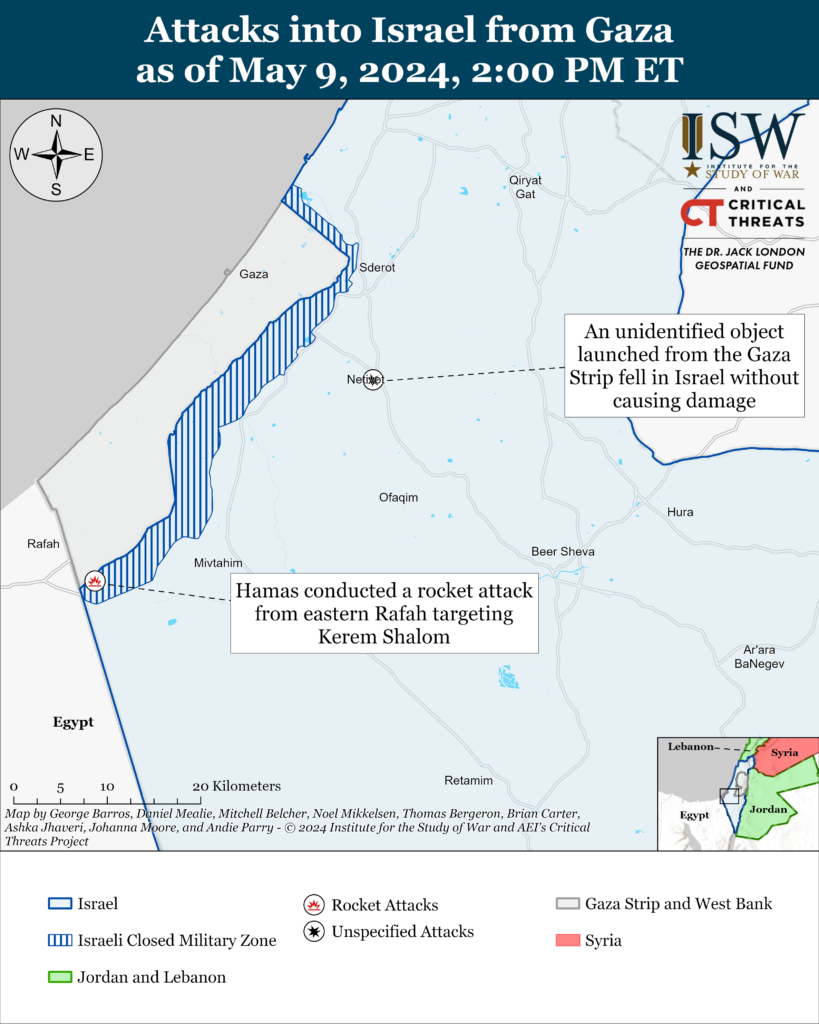
Recorded reports of attacks; CTP-ISW cannot independently verify impact.
West Bank
Axis of Resistance objectives:
Establish the West Bank as a viable front against Israel
Israeli forces engaged Palestinian fighters in at least one location in the West Bank on May 9.[xlii] The IDF detained 31 wanted individuals in the West Bank during overnight operations, including two Hamas fighter[xliii] Israeli forces also confiscated incendiary materials. The al Aqsa Martyrs’ Brigades targeted Israeli forces in Qabatiya, Jenin governorate, with ”machine guns.[xliv]
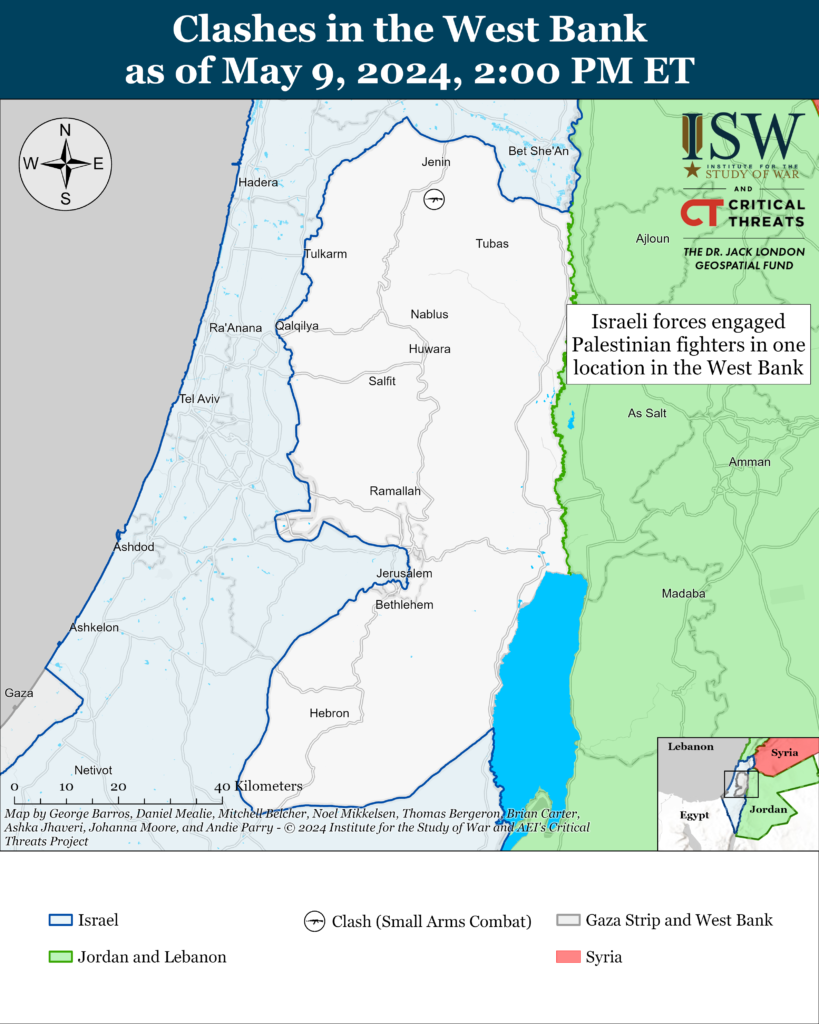
This map is not an exhaustive depiction of clashes and demonstrations in the West Bank.
Southern Lebanon and Golan Heights
Axis of Resistance objectives:
Deter Israel from conducting a ground operation into Lebanon
Prepare for an expanded and protracted conflict with Israel in the near term
Expel the United States from Syria
Lebanese Hezbollah conducted at least six attacks from southern Lebanon into northern Israel since CTP-ISW’s last data cutoff on May 8.[xlv]
The IDF conducted a drone strike that killed four Hezbollah Radwan fighters in Balfiyeh in southern Lebanon on May 9.[xlvi] Lebanese Hezbollah mourned the deaths of three of its fighters on May 9, presumably from Israeli strikes.[xlvii]
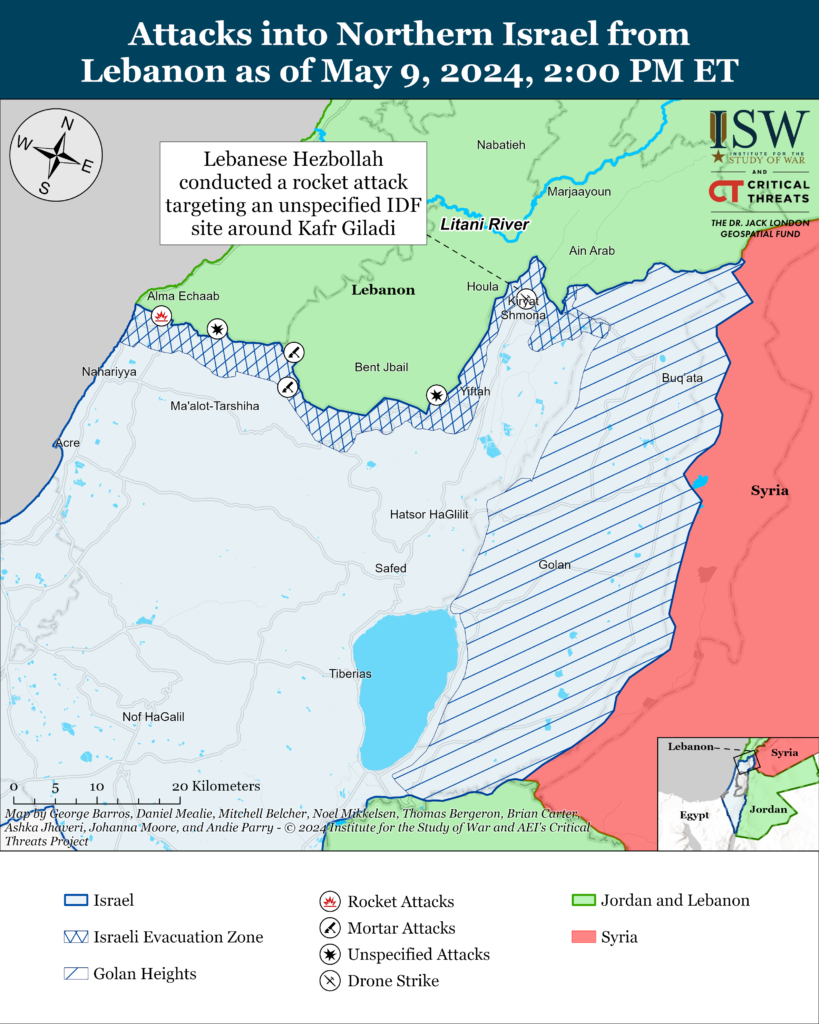
Recorded reports of attacks; CTP-ISW cannot independently verify impact.
Iran and Axis of Resistance
The Islamic Resistance in Iraq—a coalition of Iranian-backed Iraqi militias—claimed three attacks targeting Israel on May 9.[xlviii] The Islamic Resistance in Iraq claimed two drone attacks targeting Eilat and the IDF Nevatim base in Beersheba.[xlix] The Islamic Resistance in Iraq also claimed one cruise missile attack targeting the Ashkelon oil port.[l] CTP-ISW cannot verify that any of the claimed attacks actually occurred. A Syrian journalist claimed on May 8 that the IDF intercepted an Iranian-made drone over western Daraa in southern Syria.[li] The IDF has not commented on any of the attacks at the time of this writing.
Israel was likely responsible for an airstrike targeting a Harakat Hezbollah al Nujaba (HHN) site in Sayyida Zeinab, Syria, on May 9. Local Syrian media reported that Israel targeted and destroyed an HHN-operated building.[lii] The Syrian Defense Ministry similarly stated that Israel was responsible for the attack and caused material losses.[liii] HHN released a statement acknowledging the attack on one of its sites and pledging a ”sudden, strong, and effective” response against Israel.[liv][lv]
The Houthis claimed on May 9 that they conducted ballistic missile and drone attacks targeting three Panamanian-flagged vessels in unspecified areas of the Gulf of Aden, Indian Ocean, and Arabian Sea.[lvi]
Houthi supreme leader Abdul Malik al Houthi said during a speech on May 9 that the Houthis would escalate attacks against Israel following Israel’s limited operation into Rafah.[lvii] Abdul Malik said that the group would target any ships related to supplying goods to Israel regardless of the ships’ destination. Abdul Malik said that this was the fourth stage of escalation in response to Israel’s operation in Rafah. The Houthis initially announced the fourth phase of escalation against Israel on May 3 by threatening to target ships in the Mediterranean Sea.[lviii] Abdul Malik added that the group is considering a ”fifth and sixth stage” and that the Israeli operation in Rafah will be ”met with greater action at all levels.”[lix]
Iranian hardliners are continuing to normalize discussions about Iran’s ability to procure a nuclear weapon. Strategic Foreign Relations Council Chairman Kamal Kharrazi stated during an interview with al Jazeera on May 9 that Iran will have “no choice” but to change its nuclear doctrine if Israel threatens Iran’s existence[lx] Kharrazi emphasized that Iran has not decided to pursue a nuclear weapon but warned that Iran’s “level [lxi] Kharrazi is a top foreign policy adviser to Supreme Leader Ali Khamenei. Kharrazi’s decision to conduct the interview with al Jazeera suggests that he meant to send this message especially to the Arab states, such as Saudi Arabia and the United Arab Emirates. Kharrazi previously stated that Iran has the “technical means” to make a nuclear weapon but had not decided whether to pursue such a weapon during an interview with al Jazeera in July 2022.[lxii]
Other senior Iranian officials have similarly discussed openly Iran’s ability to produce a nuclear weapon in recent weeks. The Islamic Revolutionary Guards Corps (IRGC) Nuclear Security and Protection Corps Commander Brig. Gen. Ahmad Haghtalab announced on April 18 that Iran will change its “nuclear doctrine and policies” if Israel strikes Iran’s nuclear facilities.[lxiii] Haghtalab’s statement preceded the Israeli airstrike on April 18 that targeted an Artesh Air Force base in Esfahan City, Esfahan Province, approximately 112 kilometers south of the Natanz Nuclear Complex.[lxiv]
Iranian Ambassador to Belarus Ali Reza Saneyi discussed Belarusian-Iranian political and economic cooperation with Foreign Affairs Minister Hossein Amir Abdollahian in Tehran on May 9.[lxv] This meeting follows Abdollahian’s meeting with Iranian Ambassador to Russia Kazem Jalali in Tehran on May 8.[lxvi] Abdollahian and Jalali discussed Russo-Iranian transit, financial, and banking cooperation.
 Eurasia Press & News
Eurasia Press & News
